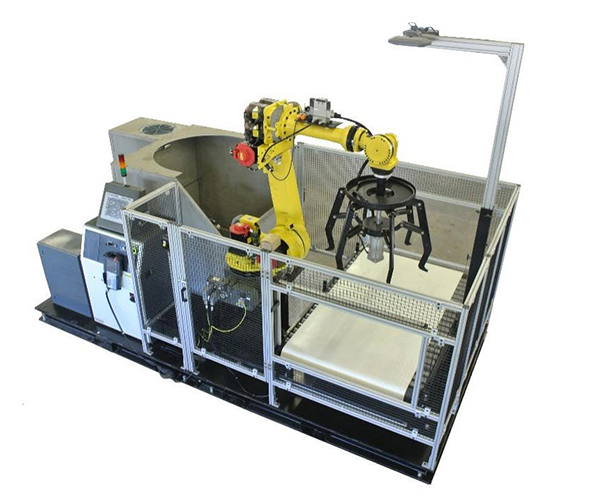Robotic Tire Spray Machine

Solution
This customer had been introduced to Pioneer Industrial Systems at a trade show. Our engineering team worked with sales to review their stringent specifications and present a solution. We then used the TireTech Hannover show to meet up again and review our proposal.
Our engineers have been working with the tire industry since the late 1980s, so we understood the importance of keeping the mold release away from the build machines and what a mess the overspray could make. We already had our RTS1000i solution with our patented Precision Fluid Delivery System, which would be ideal for this application to both minimize overspray as well as handle the variations of tires coming into the system at random. We had to customize the system for the scales, tire containment, additional conveyors required, and the data acquisition and transfer.
Also with our engineers full understanding of the NEC and having a good relationship with Fanuc Robots and Rockwell we were able to work through the CE requirements.
Pioneer had completed several successful tire spraying machines and white wall spraying machines that operated in a dual-mode, with both recipe and adaptive intelligence. This dual-mode allows for a distinct recipe to be attached to each product code but also gave the freedom for adaptive intelligence to kick in if the barcode was not recognized or a recipe did not exist. This utilized lasers and cameras to find the actual dimensions of the tire and its exact location in space to locate and pick the tire successfully. The system then calculated how to spray the optimal pattern by adjusting gun location, fan pattern, atomizing air pressure, and the spray pump RPM. This dual-mode and PFDS resulted in a precise spray and maintained consistent uptime, with tires entering the system entirely at random.
After providing the customer with a proposal that included a 3D Concept and Simulation, the customer was able to effortlessly sell the robotic system to. It was approved within the budget and a PO was issued for the machine.
Pioneer started its defined Machine Building Process. This process involved detailed engineering kickoffs, where we worked closely with the customer on getting signed approvals for mechanical layouts, electrical schematics, and programming structure. As the project came together on the floor, consistent updates were sent to the customer. Once it was completed, the customer came on-site for five days of runoff on Pioneer’s floor, putting the machine through its paces and completing both the customer’s checklist and Pioneer’s own internal checklist. The customer had the chance to make a few minor tweaks, but due to the communication at the front and throughout the project, minimal changes were required before shipment. After the customer runoff, the machine was disassembled, shipped, and Pioneer’s assembly crew went on-site to install the equipment. Since the design was modular, the installation was completed in only five days. The programming engineer was on-site the following two weeks to connect our system to the plant conveyors and higher-level server. After a few days of commissioning, several days of operator, maintenance, and plant engineer training followed.
The customer was given support documents and was well taken care of after the startup was completed. This includes machine drawings, a detailed machine manual, the latest copies of the robot and PLC programs, and a spare parts list.
Outcomes of Success
Overall, the project was very successful. The system was installed on schedule. The spray was contained with minimal to no overspray getting outside of the spray booth.
CE Certification and Cycle times were met per the specifications.
The plant engineer was involved throughout the project, so he was always aware of status, any obstacles and felt comfortable throughout the entire process.
Mold release consumption was considerably lower than comparable machines due to our Precision Fluid Delivery System, which was a substantial cost savings. Specific figures were not shared with Pioneer, only the mention that the material savings on mold release was significant, in the 25-50% range.